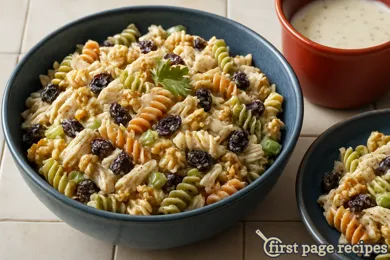Why Bronze Cut Pasta?
Why bronze cut pasta? It's better because it's rougher, and that means it holds sauce better.
 Bronze-cut penne rigate (top), and Teflon-extruded (bottom)
Bronze-cut penne rigate (top), and Teflon-extruded (bottom)
If you're like me, the first time you saw "Bronze Cut" on a package of pasta, you thought "Why would I pay 2 or 3 times more for a bag of pasta based on what the knife they chopped it up with is made from?"
It's not really about "cutting"...
Commercial pasta is made from a dense dough extruded (pushed) through a die. The die is a metal plate with holes in it that are in the shape of the profile of the pasta being made. The dough is pushed through the holes, and the pasta comes out the other side. The shape of the hole determines the shape of the pasta.
There are two types of dies used in pasta making: Bronze and Teflon. Bronze is a metal alloy made with copper, tin, and other metals. Teflon is a brand name for a synthetic fluoropolymer of tetrafluoroethylene, known by the chemical name polytetrafluoroethylene (PTFE). Teflon is best known for its non-stick properties, and it's frequently used in non-stick cookware.
Pasta Economics
Pasta dies wear out as they are used, and need to be replaced regularly. When you're running a factory that makes pasta, you factor in the amount of pasta you can make with one die, and the cost of replacing the dies regularly. In this math, using Teflon is ultimately less expensive. This is why most high-volume commercial pasta is made with Teflon dies, and it's also why it's less expensive on the store shelf.
 Close-up showing surface of Teflon-extruded pasta.
Close-up showing surface of Teflon-extruded pasta.
 Close-up showing surface of bronze-extruded pasta.
Close-up showing surface of bronze-extruded pasta.
Bronze-cut Pasta Benefits
Bronze-cut pasta might seem like a gourmet indulgence, but it actually has a unique texture and flavor profile that justifies its higher price tag. The process of cutting pasta dough through bronze dies, as opposed to Teflon, results in a coarser surface as shown in the photos above. This roughness is key to the pasta's culinary magic: it allows sauces to cling better to each strand or shape, ensuring a more flavorful and cohesive dish. The rougher surface of bronze-cut pasta also means that the outside of the cooked pasta will cook faster than the inside, resulting in a great combination of al-dente bite and creamy texture.
Also, the bronze cutting technique often goes hand-in-hand with a slower, less industrial and more artisanal production process, which can contribute to a superior taste. In the world of pasta, these subtleties make a world of difference, elevating a simple meal to a more sophisticated culinary experience. Whether it's the classic spaghetti or more intricate shapes like orecchiette, the bronze-cut method imparts a distinct texture that is prized by chefs and food enthusiasts alike.
Is Teflon-extruded pasta unhealthy?
Teflon is considered food-safe by policy makers, and the amount of the material that is in dried pasta is probably trivial in comparison to food cooked in non-stick cookware. That said, there are some concerns about the safety of Teflon, and the chemicals used in its manufacture. What you eat is a personal choice, and you should make your own decisions about what's on your plate. If you're concerned about PTFE (Teflon) in your food, then bronze-cut pasta is a good choice.
What to Look for
 Bronze cut pasta isn't difficult to find these days. Nearly every store sells it, and it's easy to identify. Here's somewhere to start: Garofolo pasta is a renowned variety of Italian pasta that originates from the picturesque town of Gragnano, located in the Campania region of Italy. Gragnano is often hailed as the "City of Pasta" due to its centuries-old tradition of pasta making. The town's unique climate, with a perfect mix of wind, sun, and humidity, is ideal for drying pasta, contributing significantly to the pasta's distinct quality and texture.
Bronze cut pasta isn't difficult to find these days. Nearly every store sells it, and it's easy to identify. Here's somewhere to start: Garofolo pasta is a renowned variety of Italian pasta that originates from the picturesque town of Gragnano, located in the Campania region of Italy. Gragnano is often hailed as the "City of Pasta" due to its centuries-old tradition of pasta making. The town's unique climate, with a perfect mix of wind, sun, and humidity, is ideal for drying pasta, contributing significantly to the pasta's distinct quality and texture.























